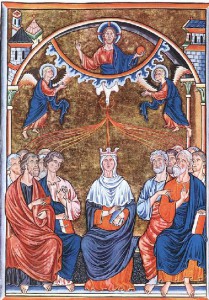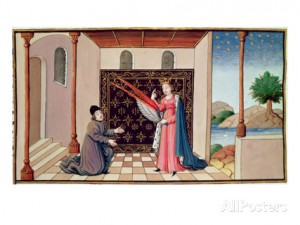 Let’s look at the Collect for Pentecost as it appears in the Missale Romanum of St. John XXIII. You will recognize it as the prayer after the Veni, Sancte Spiritus:
Let’s look at the Collect for Pentecost as it appears in the Missale Romanum of St. John XXIII. You will recognize it as the prayer after the Veni, Sancte Spiritus:
Deus, qui corda fidelium Sancti Spiritus illustratione docuisti: da nobis in eodem Spiritu recta sapere, et de eius semper consolatione gaudere.
This ancient from at least the time of the Liber sacramentorum Gellonensis and probably older. It survived the Consilium’s scalpels to live in the Novus Ordo only as the Collect for a Votive Mass of the Holy Spirit, though it was shoved to the back of the bus in favor of two Collects from the Gelasian Sacramentary, also existing in the Hadrianum version of the Gregorian Sacramentary.
There is nothing especially challenging in the Latin vocabulary. Our source of Latin consolation and wisdom, Messrs. Lewis & Short’s dictionary, says that sapio (infinitive sapere) means first of all “to taste, savor; … to have a taste or flavor of a thing”. Logically it is extended to “to know, understand a thing”. It is often paired in literature with the adverb recte, “rightly”, when wisdom is indicated. Think of the English word “insipid” (the sap- shifts to sip-) for something without flavor and also a person without taste or wisdom. We might think of homo sapiens as being one of “good taste”, who knows the savor of life, as it were. Sapiens is thus connected with Greek sophos, or “wise”, or “sage” (also a savory herb!). Sapientia, “Wisdom”, is a figure for the Holy Spirit as well as one of His Gifts. The Holy Spirit, Parácletus, is our Counselor, leading us rightly, and Comforter, bringing us consolation.
LITERAL TRANSLATION:
O God, who taught the hearts of the faithful by the light of the Holy Spirit, grant to us, in the same Spirit, to know the things that are right, and to rejoice always in His consolation.
What leaps to my mind, steeped in the literature of late antiquity, is the connection of wisdom, inherent in the phrase recta sapere, with consolation.
 There was a genre of consolation literature in classical times and late antiquity into the medieval period. This was part of the province of philosophy (“love of wisdom”). This literature was used as a moral medication for the soul. In the famous work of the imprisoned Boethius (+525), the Consolation of Philosophy, Lady Wisdom, Philosophy, comes to the author in his cell before his execution and diagnoses the true nature of his sickness of sadness. She does this in a dialogue, so that Boethius can understand things rightly (like our recta sapere), and therefore be consoled. Lady Wisdom descended so as to raise Boethius up to God. This is our pattern too, both in creation and in our renewal when we have sinned. I have mentioned before when pulling these prayers apart how many collects show the influence of the ancient philosophical concept of that all creation proceeds from God (exitus) in and then turns about (conversio), thus to take determinate form and return again to God (reditus). The prayers we have that result from late antiquity often ancient philosophical concepts. We can’t discern what they really say without knowing these ancient rhetoric and philosophy.
There was a genre of consolation literature in classical times and late antiquity into the medieval period. This was part of the province of philosophy (“love of wisdom”). This literature was used as a moral medication for the soul. In the famous work of the imprisoned Boethius (+525), the Consolation of Philosophy, Lady Wisdom, Philosophy, comes to the author in his cell before his execution and diagnoses the true nature of his sickness of sadness. She does this in a dialogue, so that Boethius can understand things rightly (like our recta sapere), and therefore be consoled. Lady Wisdom descended so as to raise Boethius up to God. This is our pattern too, both in creation and in our renewal when we have sinned. I have mentioned before when pulling these prayers apart how many collects show the influence of the ancient philosophical concept of that all creation proceeds from God (exitus) in and then turns about (conversio), thus to take determinate form and return again to God (reditus). The prayers we have that result from late antiquity often ancient philosophical concepts. We can’t discern what they really say without knowing these ancient rhetoric and philosophy.
Think now of our prayer and also the Veni Sancte Spiritus with which it is connected:
“Come, Holy Spirit, fill the hearts (corda) of Thy faithful and kindle in them the fire of Thy love. V. Send forth Thy Spirit and they shall be created R. And Thou shalt renew the face of the earth.”
In the Holy Spirit, who breathed life into the Body of Holy Church on Pentecost, may we all be renewed. May He help us to return to God when we have strayed, and to return to each other in the embrace of our Holy Catholic Church when we have parted from clear unity.


































Veni Sancte Spiritus reple tuorum corda fidelium et tui amoris in eis ignem accende.
Emitte Spiritum tuum et creabuntur – Et renovabis faciem terrae…
I pray that every night before going to sleep. Thank you Father for the explanation of that wonderful prayer.
I learned this prayer as a child at school although the translation is just a tiny bit different:-
O God, who hast taught the hearts of Thy Faithful, by the light of Thy Holy Spirit, grant that by gifts of that same Spirit, we may be always truly wise and ever rejoice in His consolation, through Christ, Our Lord. Amen
The bit which has always stuck in my mind is that of being “always truly wise”. I can still remember one of my teachers talking to us (primary school children) of just what true wisdom is! I would have been about seven or eight years old at the time.
For those who like music, check out Josquin’s beautiful setting (go to Amazon, and search Josquin + veni + sancte), Dunstable’s (ditto) or, even better, the Huelgas Ensemble’s recording of a Pentecost Vesper service (Huelgas + pentecost). For me, listening to music like this is a every bit a form of prayer.
You cannot go wrong with almost anything by Josquin. My personal favorite is the “Deploration sur la mort de Johannes Ockeghem” – in which Josquin pays homage to his great predecessor’s magnificent bass lines and resonant harmonies.
Josquin, Deploration (“Nymphs of the wood”)
Dunstable is a little more difficult to “get” – he was sixty years earlier than Josquin and worlds away (England was always a little behind the fair in those days), and his harmonies are frankly medieval and strange to the modern ear. Plus he was a mathematician and astronomer first and it shows, especially once the inner parts get going . . . it helps to study the scores.
Dunstable: Veni Sancte Spiritus
While not “Veni Sancte Spiritus”, I do love Mahler 8, with the opening movement “Veni Creator Spiritus”.
http://en.wikipedia.org/wiki/Veni_Creator_Spiritus
The first movement is paired with the final scene of Faust Part 2. It’s a theological/philosophical mishmash, but quite wonderful. It’s the auditory equivalent of a Klimt painting. Or picture a church designed by Otto Wagner. It’s a concert hall; not Mass.
A truly glorious opening: https://www.youtube.com/watch?v=Kc996x0c1EU
“Ascende lumen sensibus”: http://youtu.be/Kc996x0c1EU?t=12m25s
“Gloria Patri Domino”: http://youtu.be/Kc996x0c1EU?t=21m18s
(The modulations from Db, the soprano’s 7th leap – she goes to a 9th later, and settling on Eb major for a while are breathtaking.)
http://youtu.be/Kc996x0c1EU?t=22m41s
The Glorias in the interval of a 7th and then the solo sopranos bumping it up to a 9th on
“Patri”. Even if Mahler remained truly Jewish until the end (despite the workplace conversion a la Mendelssohn), the Jews truly understood “Patri”, even if in a form we don’t always recognize.
And the final upswoops on “Patri”, although not that well heard in this recording with the score. http://youtu.be/Kc996x0c1EU?t=23m
Try the Haitink/Concertgebouw 1985 video for excellent final upswoops
http://youtu.be/50UnBIwbu4I?t=26m5s
Or Lenny in Vienna (ancillary brass choir in the upper balcony)
http://youtu.be/trF6-M6-4vE?t=6m35s